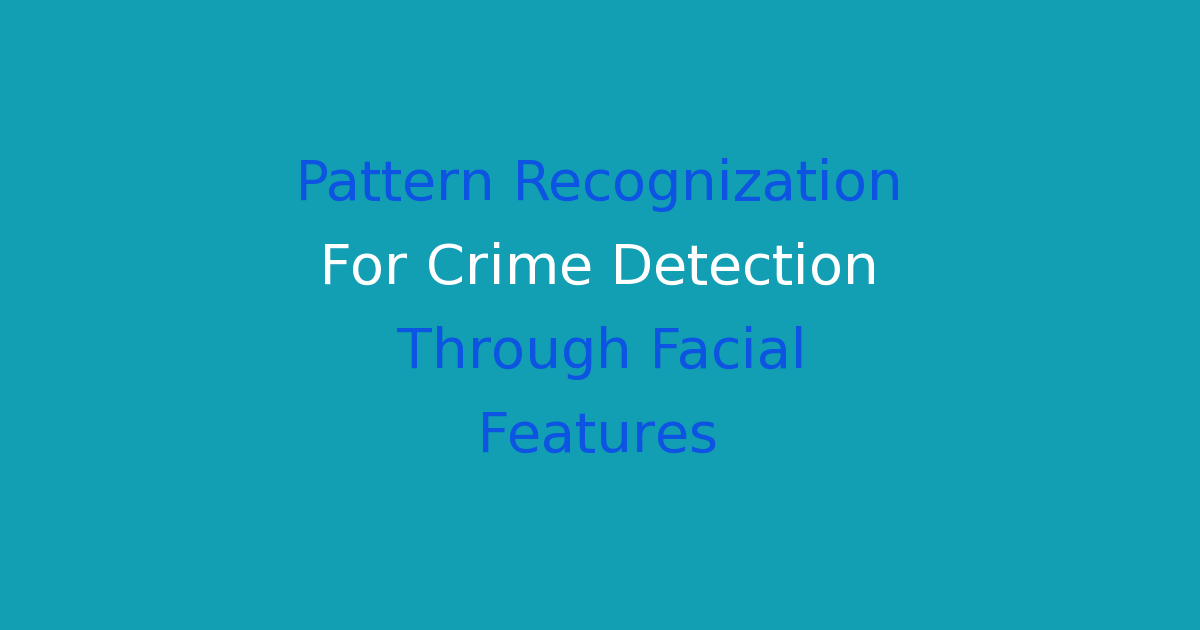Facial features are used for pattern recognition to detect crimes.
Pattern Recognition for Crime Detection through Facial Features
Introduction
In recent years, the advancement of technology has played a significant role in enhancing security measures worldwide. One of the key areas of focus is crime detection, where pattern recognition through facial features has emerged as a promising tool for law enforcement agencies. By analyzing facial features such as the shape of the eyes, nose, and mouth, patterns can be identified and matched with existing databases to identify potential suspects. This technology has shown promising results in enhancing the efficiency and accuracy of crime detection processes.
Problem Statement
Despite advancements in technology, the existing systems for crime detection through facial features have certain limitations. The current systems rely heavily on manual intervention and are often prone to human error and bias. Additionally, the accuracy of these systems can be affected by factors such as lighting conditions, image quality, and facial expressions. There is a need for a more automated and accurate system that can overcome these challenges and provide law enforcement agencies with reliable tools for crime detection.
Existing System
The existing systems for crime detection through facial features typically involve the use of facial recognition software that analyzes key features of a person’s face to create a unique biometric profile. These profiles are then compared against a database of known criminals to identify potential matches. While these systems have shown some success in identifying suspects, they are often limited by their reliance on manual input and subjective interpretation of facial features. Additionally, factors such as changes in appearance due to aging or facial hair can affect the accuracy of these systems.
Disadvantages
Some of the key disadvantages of the existing systems for crime detection through facial features include:
– Reliance on manual input, leading to potential errors and biases
– Sensitivity to factors such as lighting conditions, image quality, and facial expressions
– Limited accuracy in identifying suspects with changes in appearance
– Lack of automation in the identification process, leading to inefficiencies and delays
Proposed System
To address the limitations of the existing systems, a proposed system for crime detection through facial features can leverage advancements in machine learning and artificial intelligence. By utilizing deep learning algorithms, the proposed system can automate the process of pattern recognition and improve the accuracy of suspect identification. The system can also incorporate features such as real-time facial recognition and 3D modeling to enhance the efficiency of crime detection processes.
Advantages
Some of the key advantages of the proposed system for crime detection through facial features include:
– Automation of the pattern recognition process, reducing the risk of human error and bias
– Enhanced accuracy in suspect identification through advanced deep learning algorithms
– Improved efficiency in crime detection processes through real-time facial recognition and 3D modeling
– Ability to adapt to changes in appearance and facial expressions for more reliable results
Features
The proposed system for crime detection through facial features can include the following key features:
– Deep learning algorithms for automated pattern recognition
– Real-time facial recognition for quick suspect identification
– 3D modeling for more accurate analysis of facial features
– Integration with existing databases for seamless comparison of biometric profiles
– User-friendly interface for easy access and navigation for law enforcement agencies
Conclusion
In conclusion, pattern recognition through facial features holds great promise for enhancing crime detection processes. By addressing the limitations of the existing systems and leveraging advancements in technology, a proposed system can provide law enforcement agencies with more reliable tools for identifying suspects and improving security measures. With the implementation of advanced deep learning algorithms and real-time facial recognition, the proposed system can revolutionize crime detection processes and contribute to a safer and more secure society.

